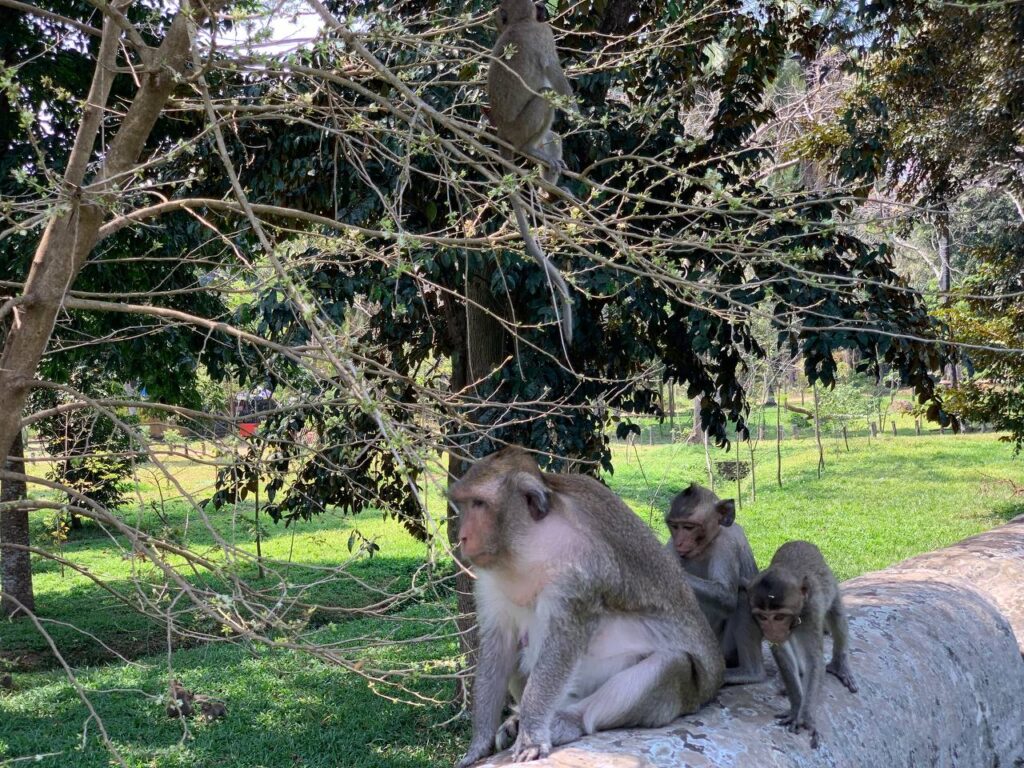ចំនួនសត្វស្វារស់នៅតំបន់រមណីយដ្ឋានអង្គរ មានការកើនឡើងគួរឱ្យកត់សម្គាល់ ជាមួយនឹងការផ្លាស់ប្ដូរ ជីវិតបែបធម្មជាតិពីស្វាព្រៃ មកជាស្វាស្រុក ដែលហាក់មានភាពសុំាជាមួយមនុស្ស។ ពួកវាលែងចូលព្រៃ ដើម្បីស្វែងរកចំណីទៀតហើយ គឺរង់ចាំចំណីពីមនុស្ស និងពេលខ្លះឆក់ចំណីពីភ្ញៀវទេសចរ ដែលបង្កហានិភ័យផ្សេងៗ។
លោក ឡេក គិមលីន ប្រធានភ្នាក់ងារទេសចរណ៍ប្រចាំប្រាសាទអង្គរវត្ត បានឱ្យដឹងថា ចំនួនសត្វស្វានៅ ប្រាសាទអង្គរវត្តមានការកើនឡើងនារយៈពេលមួយឆ្នាំចុងក្រោយនេះ។ ស្វាទាំងនោះ បានបង្កការរំខាន ដល់ភ្ញៀវទេសចរស្ទើរៀងរាល់ថ្ងៃ និងមានពេលខ្លះបានខាំភ្ញៀវផងដែរ។ លោក ឡេក គិមលីន បញ្ជាក់ពីមូលហេតុថា ស្វាខាំនៅពេលវាដណ្ដើមឥវ៉ាន់ពីភ្ញៀវ ហើយដណ្តើមមិនបានខាំតែម្តង។ ក្រៅពីនោះ សត្វស្វាក៏បានកកាយរកចំណីតាមធុងសំរាម ដែលធ្វើឱ្យប៉ះពាល់ដល់អនាម័យ បរិស្ថានដែរ។
ដូចគ្នានេះដែរ នៅតំបន់ក្រុងអង្គរធំឯណោះវិញ សត្វស្វាក៏កំពុងបង្កការរំខាន និងហានិភ័យ ដល់ភ្ញៀវទេសចរ ក៏ដូចជាថ្មប្រាសាទផងដែរ។ លោក សៀន បណ្ឌិត ប្រធានក្រុមភ្នាក់ងារទេសចរណ៍ ប្រចាំក្រុងអង្គរធំ ប្រាប់ឱ្យដឹងថា តាមការអង្កេតពីក្រុមការងាររបស់លោក សត្វស្វានៅតំបន់អង្គរធំអាច មានរាប់រយក្បាល។ ពួកសត្វស្វាទៅខាំភ្ញៀវ ទាញរបស់របរភ្ញៀវ ទាញទូរសព្ទ ទាញកាបូប ប្រតោងលើប្រាសាទធ្វើឲ្យខូចខាតបរិក្ខាទេសចរណ៍ និងជ្រុះថ្មមកក្រោម។ ក្រៅពីនេះ សត្វស្វាដែលតែងមានចរិតរពឹស បានតោងឡាន និងធ្វើឱ្យបាក់កញ្ចក់ និងបាក់ផ្លិតរថយន្ត។
អាជ្ញាធរជាតិអប្សរា សូមសំណូមពរឱ្យសាធារណជនទាំងអស់បញ្ឈប់ផ្តល់ចំណីដើម្បីថតរូបភាពសត្វស្វាយកទៅធ្វើអាជីវកម្ម ឬក៏ផ្តល់ចំណីដល់សត្វស្វាដើម្បីឱ្យស្វាទាំងនោះរស់បែបធម្មជាតិ និងមិនរំពឹងលើការឲ្យចំណីដោយមនុស្ស៕
The number of monkeys living in the Angkor area has increased significantly with the transition of natural life from wild monkeys to domestic monkeys that seem to be familiar to humans. They no longer enter the forest in search of food, waiting for food from humans and sometimes snatching food from tourists, posing a risk.
Mr. Lek Kimlin, Head of the tourism agent at Angkor Wat, said that the number of monkeys at Angkor Wat has increased recently. The monkeys annoy visitors almost every day and sometimes bite visitors as well. Mr. Lek Kimlin stated that the monkeys bit when they snatched the goods from the tourists. In addition, monkeys also looked for food in trash bins, which affects the hygiene of the environment.
Similarly, in the Angkor Thom area, monkeys are also causing the disturbance and risk to tourists, as well as temple stones. Sean Bandith, Head of the tourism agent at Angkor Thom, said that according to a survey by his team, there could be hundreds of monkeys in the Angkor Thom area. The monkeys bite the tourists, pull out the items such as phones, bags, etc from the tourists, cling to the temple, and damage the tourist facilities. In addition, the monkeys, who are always angry, clung to the car and smashed the windshield.
APSARA National Authority urges the public to stop feeding to take pictures of monkeys for business or to feed the monkeys so that the monkeys can live naturally and not expect human feeding.
Share:
Our Latest News

ទស្សនីយភាពស្រស់ត្រកាលនៃប្រាសាទខ្មែរ នារដូវវស្សាមានភាពទាក់ទាញយ៉ាងខ្លាំង -The Fresh Scenery of Khmer Temples During the Rainy Season is Truly Captivating- 06 October 2025
នារសៀលថ្ងៃទី០៣ ខែតុលា ឆ្នាំ២០២៥នេះ ឯកឧត្តម ឡុង កុសល អគ្គនាយករង តំណាងដ៏ខ្ពស់ខ្ពស់ ឯកឧត្តមបណ្ឌិត ហង់ ពៅ អគ្គនាយអាជ្ញាធរជាតិអប្សរា ព្រមទាំងសហការី បានទទួលជួបពិភាក្សាការងារជាមួយគណៈប្រតិភូមកពីទីភ្នាក់ងារសហប្រតិបត្តិការ និងសម្របសម្រួលទួរគី (TİKA)




